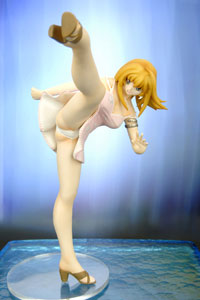 Logo handmade by Bannister
Column by Scott Green
Logo handmade by Bannister
Column by Scott Green
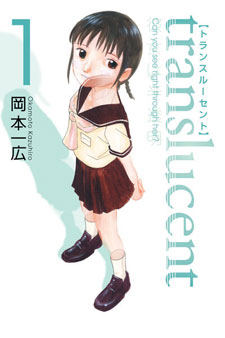
Manga Spotlight: Translucent By Kazuhiro Okamoto Released by Dark Horse Manga
Translucent is a nice collection of stories. With a positive spirit permeating the work, each episode builds is effective in presenting a testimony for the more pleasant side of human nature. Though a happy moral quickly becomes the expected conclusion for each episode, Okamoto still manages to end each episode in a manner that feels legitimately positive. However, this is a limited formula for a manga series, and one that would be better served in anthology than a collected edition. Packaged with chapters of other manga serials, its good natured perspective on school life would be a pleasant treat. Alone, the package of like stories is hard to manage, making the book a case where the volume of manga is difficult to read in one sitting. For genre fans, this may not be a first exposure to the metaphorical conceit in which an unnoticed girl actually becomes invisible. In this case, eighth grader Shizuka Shiroyama has " Translucent Syndrome", meaning that she cyclically fades into invisibility. Though she's quiet by nature, her passion is for acting, so her social awkwardness is compounded by the fear that when she needs to appear on stage before an audience of people, she might be partially or completely invisible. Okamoto constructs a cast of people around Shizuka who have their own issues of mistrust and uncertainty, or cases in which they panic, but in their own way, each is pulling for her. Shizuka's biggest supporter is her boundlessly positive male peer Mamoru Tadami, an artist who comes up with schemes like painting Shizuka's arms flesh colored. Mamoru is clearly filling the role of the author's voice, and in that capacity, he's a bit goofy, but he's also an earnest booster. With every character at least meeting his positive outlook half way, and some, such as Shizuka's popular foil going as far as to proclaim "everyone is special", the whole affair becomes unabashedly cheery. The suggestion that when the emotional cluttered is cleared away, people basically mean well. Okamoto's use of gaps or perspective with zip tones spaces is an effective way of capturing the invisibility. Often, it is a unique looking effect that is appropriately strange. When he does have to Claude Rains, such as in the case of a woman who is always invisible, the way he catches the physical dimension of the person is still an interesting touch for manga. The appeal of Translucent is worth mentioning. Dark Horse refers to the manga as something that shojo fans would be interested in. That assertion is far from disingenuous, but it also isn't strictly true. If the term is used as short hand for manga in which the paramount concern is interpersonal relationships and their accompanying emotions, than it is valid to apply it here. The manga was originally serialized in Comic Flapper, a seinen anthology for older, male audiences, but Azumanga Daioh, Yotsuba, Aria, Gunslinger Girls, and Kamichu are all also published in seinen anthologies even though in North America, they don't have the same audience as the likes of Berserk or Blade of the Immortal. The strongest suggestions that the series is in fact seinen are focused around the Mamoru character. Fortunately, the issue is not that Shizuka becomes defined by Mamoru's faith in her. Instead, it is more a gentle inclusion of points of male interest, especially an affection for plamo (plastic models). "It's nice to be nice" is a bit of a novel twist for an manga relationship story, and Translucent handles it respectably. The sense of responsibility and complexity is present, but light, but unlike some light hearted seinen, there's not a retrograde, reductionist "think like a child" attitude. As a collected edition, it is a pleasant manga to have around.
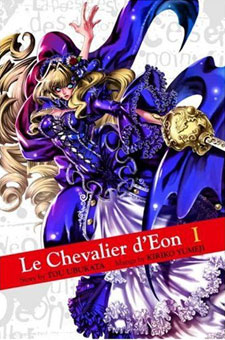
Manga Spotlight :Le Chevalier d'Eon volume 1 Story by Tou Ubukata Manga by Kiriko Yumeji Released by Del Rey
Kiriko Yumeji's manga adaptation of Tou Ubukata's Le Chevalier d'Eon actually commenced about 10 months before Production I.G's anime adaptation. The manga also more closely resembles the spirit of some of Ubukata's other works, such as Pilgrim J‰ger. However, given that the anime is significantly better known in North America than either the manga or the original novel, the manga plays a lot like a warped reflection of the anime. Ubukata's novel invented a supernatural explanation for the life of Chevalier d'Eon, a historical 18th century French diplomat and spy who is remembered for cross-dressing during his missions and living his later life as a woman. In the case of Ubukata's fictionalized d'Eon, the young nobleman and member of King Louis XV's secret police began sharing a body with the soul of his beloved sister after her murder by a conspiracy of magician philosopher Poets. Production I.G shaped this into something of a court of Versailles/foreshadowing of the Reign of Terror, Ghost in the Shell, with plenty of politics, webs of intrigue and Count of Saint-Germain/alchemy legends in the place of technology. Yumeji's manga instantly establishes itself as far more manic than the anime. A wild haired mad man is ranting about the bloods of virgins as he carves "psalms" and "palmsss" into the severed hands of a young woman and pound spikes into a bloody scroll. A squad of gendarmes, who in their hard-hats and tunics look as much out of Judge Dredd as they do the 18th century, break in and see the corpses of women hung from hooks, dripping blood, along with severed heads and more carved hands. As the mad poet leaps out of the room, and crawls Dracula like to the roof, he is confronted by a woman in a gown, that in its prominent corset and billowing skirts, looks part fairytale, part modern loli-goth exaggerated pastiche. The woman draws an oversized saber and the two engage in a roof top battle, after which, she leaps off, onto a running horse in order to escape the police on-scene. The Ubukata/Yumeji Le Chevalier d'Eon is a far pulpier work than the anime. This d'Eon is essentially a transgender Scarlet Pimpernel or Batman. By day he is an unreliable fop who sleeps at inappropriate times, shirks duty, and jockeys for position. By night, he becomes a female, dark avenging angel. The joke about the anime was that d'Eon's young page Robin was the "Robin" to d'Eon's "Batman." In this case the reference certainly looks intentional. The appeal of the anime is the intricacies of Production I.G's work, from plotting, to action, to the models for Paris. The manga is more sensational and Yumeji pulls out all the stops. First d'Eon is dressed in a gonzo rococo gown, then the character goes through the urban rooftop acrobatics familiar from American superhero comics in the backdrop of period France. With all the corpses and messages scrawled on walls in blood, it is an intentionally seedy affair. Serialized in Magazine Z (home of Go Nagai's Mao Dante, Hajime Ueda's Q-Ko Chan and FLCL and Kia Asamiya's Batman: Child of Dreams), there is plenty of seinen gleeful chaos throughout. It's a inspired high concept that has been well executed, but Yumeji is not pushing it beyond what is initially presented. Unlike more sustained madcap seinen works such as Apocalypse Zero or Violence Jack, from chapter to chapter, Yumeji is not working to shake up the flow or outdo the last episode. One serial killer who turns into a reptile monster is a lot like the next. One volume of Le Chevalier d'Eon is a worthwhile, dizzying experience. Whether a second volume adds anything remains to be seen.

Manga Spotlight: Alive: The Final Evolution written by Tadashi Kawashima illustrated by Adachitoka Released by Del Rey
The two problems that discredit Alive are that it evokes ideas that are executed in bone chilling fashion elsewhere and that it is slavish in casting its protagonist in the model of the heroes of popular manga. As a tradition, Manga is laudable for the topics that it is willing to tackle, but Alive demonstrates that sometimes, it is worth exerting some care in selecting topics and fitting the selected topic into the standards of a genre. Suicide as a contagious phenomenon, or a phenomenon caused by a contagion has long been fodder for Japanese horror movies. There, the dark intensity of cinema serves the topic well. When taken to manga, such as Usumaru Furuya's version of Suicide Circle, the medium has illuminated the ideas with a disturbingly close inspection. Alive joins this take on suicide with boys' shounen manga, and in doing so, inherits all of its bad habits. There's a boisterous young hero who looks after his sensitive friend, a close, almost romantic attachment to a girl he grew up with, and the fact that after being orphaned as a child, he was raised by his elder sister, who is now a teacher at his school AND routinely acts flirty towards her brother. Parasyte proves that unyielding ideas about mortality and violence can be paired with irreverent teen moments. Alive throws them together without realizing that joking incestuousness and skirt flipping, which are tiresome in any context, really don't belong in a conversation about suicide. There is room between something that is strictly adult and disturbing like Homunculus and typical shonen works. Series like Parasyte have found the space to operate within those boundaries. Alive does offer genuinely disturbing sequences, in which there is panic, overpowering certainty, then as the haze of the moment clears up, a scene of carnage. More often than not, everything comes across as a story conceit. For example, there are so many harsh scenes of bullying in manga that when Alive opens with one and expects the torment to matter and the lead to come across as charmingly goony, the series immediately sets itself up for a negative reaction. Alive doesn't just rely on familiar shounen elements in terms of borrowing them. It demonstrates an expectation that just by invoking them; the reader will understand and be affected by the notion as deeply as if they were fully established in this manga. In the middle of a lunchroom scene where the romantic interest had been eating with her friends, the girl announces "I'm off to see my childhood buddy you guys were just talking about." It is unusual for a manga not to be written and illustrated by one person (with uncredited assistants), and maybe the divided duties here explain why Kawashima just crams in details like "my childhood buddy" or a sudden jump to the hero and his sister as children crying in the rain at the parents' funeral. With the manga tossing out these character sketch details, and having the details match the history of so many other manga principals without any exciting, profoundly new details, Alive never establishes its own credibility.
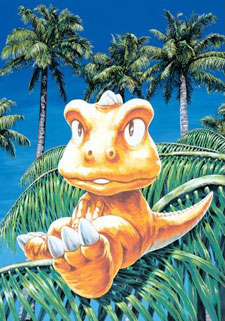
Manga Spotlight: Gon Volume 1 by Masashi Tanaka Released by CMX
A collection of funny animal stories might not sound like must read manga, but Masashi Tanaka's Gon combines breathtakingly detailed illustration and clever physical humor to make irresistibly charming classic. In all sense of the term, this is a true all ages comics. Especially at $5.99 a volume, it's a good idea to purchase multiple copes: you'll want one for yourself and a few more to give away. Gon is a miniature tyrannosaurus rex with a bad disposition. In North America, he gained a brief, targeted notoriety as a hidden character in Tekken 3 (if you saw his ending, that's a sample of what the manga offers). And he'll be back for more fame when the upcoming CGI movie from director Moto Sakakibara(Final Fantasy: The Spirits Within) and Sprite Animation Studios hits. Each wordless short story is set in a different ecosystem filled with some variety of modern fauna. The major operating conceit is that the series features a small dinosaur popping up an any spot on the globe to experience nature at that locale with no signs of humanity. Beyond that, the wildlife is anthropomorphized in the sense of applying human mental and especially emotional characteristics. It's not Bugs Bunny, but it is a step beyond March of the Penguins. For the most part, Gon's role is to assert himself at the top of the food chain: beat up the bear for a claim on the salmon, then nap on the belly of the newly subservient beast, ride on the back of a very displease lion on the way to the wildebeest, show up the beavers in building a monumental dam. There is a pure simplicity to the stories, where part of the appear is a that this fierce little guy stands as a a totem for vented frustration. One would be hard pressed to call him a benevolent king of the younger, and what passes for a softer side is still a function of his headstrong attitude, but the character does have his principles and empathy. The final story of the volume, "Gon Goes Flying" starts with the tiny dino imposing on a nesting eagle, but when Gon stands up with his adopted brethren, the story evolves into something more touching. Even as it is impossible not to feel pity for the abused while life, Gon is a charismatic bully. The design for Gon himself evolves a bit to acquire a slight abstraction in his rendering. He goes from a very narrow, very reptilian form to a broader, somewhat more cartooned shape. Even then, all of the scales, ridges and veins are captured in the detailed illustration. Every panel of the manga looks like a carpel tunnel nightmare. Tanaka applies human expressions to the animals' faces, but beyond that, he approaches every panel with a naturalistic style of rendering. Every aspect of each landscape and creature is depicted with incalculable detail in Tanaka's fine lines. Whether it is a forest or a mountain top, Tanaka's illustration suggests the genuine location, populated by the genuine fauna. With the realism of the technique and the pantomime of the animals' anthropomorphic expressions, the much talked about uncanny gap seems like it could be a potential issue. A chipmunk that looks like a real chipmunk, but face-faults when Gon knocks down a tree sounds like it could be unreal enough to remove the reader from the experience. However, there is consistency and exactness that allows the illusion to function. Every animal and every environment looks credible, and every expression looks creditable. Without a second thought, the complete image clicks, and what is presented can function as funny animals.
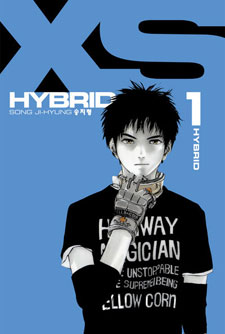
Manwha Spotlight: XS Hybrid Song Ji-Hyung Released by Dark Horse Manhwa
XS Hybrid is the teen manga/manhwa equivalent of a Jason Statham Transporter/Crank action movie. The real sales pitch for the manwha comes after a brief character/situation prologue, when a thin man in a suit with spiked, dyed hair goes Terminator on the JFK Airport. As tacky as that sounds, the John Woo meets Shadow Run character of the action is so unabashedly unreal that the situation does not push any post 9-11 hot buttons. As soon as the guy steps in, things get interesting. He dodges a special-op's automatic weapon's burst, fires a pistol shot into that attackers face, throws him at another attacker, side kicks another guy into the air and lets him have it with both pistols, then cross his arms and shots a guy on each flank. The results are fantastic in the sense that they are amazing and fantastic in the sense they are hugely BS. There is a plot to XS Hybrid, but it is a bit ropey and a bit irrelevant. It's something about a psychic girl who can transmit something important by locking eyes with a receiver. When she was young her friend took a look and fell into a three day coma. Now, he's a crazy daredevil punk and the pair are embroiled in an international tussle. Song Ji-Hyung clearly spent some time inventing a world for XS Hybrid with an alphabet soup of secret government agencies, biomechanical viruses, and the like. XS Hybrid is not exactly plotless and Song Ji-Hyung isn't exactly careless about plot, but neither aspect is given the time or the justification to take hold. Even when the characters are in their own element, their motivations and traits seem limited to what is needed to support the story. Though background details are present and built out, they are not distinct or provocative enough to be intriguing. Comics are not necessarily a medium that lends itself to fast paced, very motion based action scenarios such as car chases, but Song Ji-Hyung delivers some solid spectacles. Given that motorcycles are involved, Akira inevitably enters the conversation, but with blurred headlights, and almost audible screeching tires, the anime jumps to mind as quickly as the manga. Song Ji-Hyung alters the flow of panels and fits so many speed lines into each frame that the velocity feels palpable. This brand of twisted metal action is rarely this exciting in comics. There's a real sense of danger as the motorcycles slide between cars, end even more as the cars collide, or in great use of the sequential format, an out of control vehicle suddenly looms in front , or even over the rider. Song Ji-Hyung really masters the speed lines and puts them to good use. Neither this visualization of super powers like bursts of speed and strength are new to comics, but when a XS Hybrid character catches a punch, spins around his foe, and kicks the guy 100 feet into a soon to be crumpled car, you can see the exciting results of Song Ji-Hyung's vigorous application of the former into the latter.

Manga Spotlight: Venus Versus Virus Volume 1 by Atsushi Suzumi Released by Seven Seas
One of Venus Versus Virus' chapter title illustrations features its point of view character, Sumire, sitting in a chair, dressed in a black cabaret gown, complete with wrist to shoulder gloves, as the series' action lead Lucia places a hat on Sumire's head. The issue here is not so much that you have a young teenage girl who looks like she's about ready to go on stage in a Weimar nightclub. Plenty of manga, such as the comparable supernatural battle Bleach, go out of their way to dress their characters ib outlandish fashions for their chapter illustrations. Yet, here, the dominant appeal of the manga is that it features cute girls in exotic "gothic lolita" attire who are in the business of fighting monsters. Because the fashion is different, the manga series is inherently more interesting than another entry in the line of supernatural battles with girls in school uniforms or super hero spandex. But, when that aesthetic receives focused to the exclusion of adding extra dimensions to the characters, the series suffers. The players in Venus Versus Virus often function like dolls or action figures in that they often seem limited to showcasing attire and occasionally engaging in an action scene. After a detention, Sumire is walking back to her dorm late at night, when she spies a brooch sitting on the ground. When she picks it up, she pricks her finger, and her vision starts shaking. The next day, still feeling feverish, as she is walking to class she sees a disgusting, crawling creature lurking in the shade of the campus hedge. This thing follows her, and then attacks, but as it is charging, it is shot down by a girl with an eye patch and two long ponytails, who introduces herself as Lucia. She informs Sumire that in thanks for returning her brooch, she'll give Sumire a discount on her typical rescuing fee, then hands Sumire a flyer for "Venus Vanguard: Jewelry and Clothes" before leaping off. Venus Versus Virus is a shonen (boy's) manga published in Dengeki Comic Gao!, an anthology largely comprised of bishojo (cute girl) series. This periodical has been the source of DearS, Burst Angel, Club-To-Death Angel Dokuro-chan and Best Student Council. A key focus of the manga is presenting Lucia in her loli-goth super hero uniform and re-outfitting Sumire for as many occasions as possible. The flip side of seeing these outfits posed by the characters and in motion is that Suzumi offsets light hearted (Sumire) or sardonic (Lucia) tendencies with a gothic counter-world presented by the manga's adversaries. While the manga is too caught up in its fashion conscious concept to fully operate as a work of horror, it is peppered with striking tableaus. Like scenes in the early phase of Berserk, Venus Versus Virus harrowingly suggests monsters encroaching on the human world, literally lurking in the shadows. When these threats fully manifest themselves, they ooze and grab, and that might be off-putting. However, Suzumi's horror storytelling really works best when it utilizes the more alien facets of the everyday, such as a creature pawing from the reflection sides of mirrors. Unlike the most popular shonen works, Venus Versus Virus' personalities have little drawing power beyond their appearance, and there is little to the characters beyond their aesthetic function. Opportunities to extend them beyond the focus of Venus Versus Virus is blurred out. For example, when Sumire tells her parents that she'll be leaving the dorm of her private school to move in with Lucia, the scene is played as a brief joke. Her parents weep with joy that their daughter has grown up and is making decisions for herself. These characters do have personalities, they do react to their situation, but there is little to them other than the role they place in the high concept.
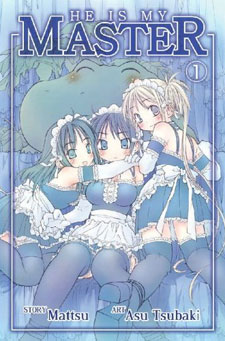
Manga Spotlight: He is My Master Story by Mattsu Art by Asu Tsubaki Released by Seven Seas
He is My Master has done the world of anime and manga a favor. It's demonstrated how far the whole maid fetish business could be taken, with results that are muddled between dark comedy and a real ugly exercise in pandering. If it was a real blue series that could really set fire to the concept, it could work as a farce. If it is supposed to be a parody, the trouble is that it ran in a shonen anthology (one that runs Kingdom Hearts manga). Unlike the satires that ran in Pulp, specifically Usamaru Furuya's Short Cuts and Masahiko Kikuni's Heartbroken Angels, He is My Master engages in what is presumably spoofing. Consequently, for the series to be funny, you have to be able to ignore some nasty implications or you have to be irreverent enough to laugh at unironic suggestions of really ugly social situations. Nor is the sexually suggestive outfits mixed with the Cabbage Patch Kids cherubic character design doing the series any favors. With the death of his parents, fourteen year old Yoshitaka Nakabayashi acquired a lot of land and a lot of money. He then commences snickering over the realization that he no longer has parents to boss him around. Rather than take care of himself, he decides to hire a maid, and seizes upon the opportunity to employ a pair of runaways sisters: fiery Izumi and sweet but mischievous sister Mitsuki. There's a bizarre, equally disquieting back-story to the pair concerning why they ran away that involves Mitsuki's clothes eating pet alligator Pochi combined with their parents' youth, and if not abusive, at least very inappropriate behavior towards their daughters. The closest that He is My Master gets to subversiveness is that the sisters aren't subservient, except, how they react is exactly what is expected from this type of story. The difference between this, and almost every other "harem" relationship comedy is that rather than a hapless romantic lead being browbeat by the girls around him for accidentally coming in contact with them, there is an unrepentant letch that is punched or attacked by an alligator for making the girls dress in micro skirts, open backed tops and garter belts. The manga is so inescapably a social services nightmare that it is hard to laugh at the antics. That all the characters are bent doesn't even anything out. In the whole spectrum of manga, there are works that are far more disturbing than He is My Master, as there is far more violent media than the trouble video game Manhunter 2. But the context in which He is My Master Master is presented, it seems directed to produce the worst results. At the same time, doesn't speak well to the direction of anime and manga that something this far out of bounds seems like an expected extension of what's popular and not a shocking outlier.
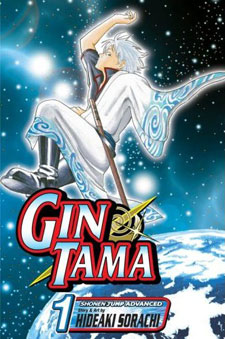
Manga Spotlight: Gintama Volume 1 by Hideaki Sorachi Released by Viz Media
Gintama is still running after four years in the Japanese edition of Shonen Jump, source of the most popular anime/manga series, including Dragon Ball Z, Naruto and One Piece, so presumably the manga has some legs. One volume in, the premise is intriguing, but the execution has been a bit lackluster. The manga starts as Ruruoni Kenshin with aliens. It's alternate history diverges from reality when, in the 19th century, rather than Perry arriving to forcibly open Japan to trade, extra-terrestrials arrive, and turn Edo (modern day Tokyo) into a space-port. The results are an outpost full of plenty of Star Wars cantina style weird aliens where the native population is in period attire, living in period buildings, but the streets are full of 20th century technology like motor vehicles and the skies are full of floating alien wizardry. The titular Sakata Gintoki is a shade off the Kenshin/Vash the Stampede model, or more to the period point, the underestimated wanderer like Zatoichi. In other words, while he's a foolish guy (a lot of the humor revolves around his love of sweets and hypoglycemia) he has a serious history. Part of the manga is goofing on someone with identity in that time and place, and part is goofing on what is expected from the character in that rather than being a particularly impressive fighter, Gintoki is the best of a bad bunch. Sorachi is a decent action illustrator. When Gintoki squares off against a rampaging tentacle monster "pet", Sorachi makes the pre-throw-down-moment look appropriately intense. Except, the fights are supposed to be a bit screwball, and while they aren't cartoonish, with exaggerated physics and design, they are zany. Furthermore, because Gitama does not appear to strictly be a bad-ass, things mostly just get hit. Plenty of manga start off with one hit battles, but in those cases, it is done with a presence that suggests when things really get serious, and the force is stepped up, the results will be full fledged spectacles. In Gintama, maybe intentionally, there is no direction mapped out for the action to get more impressive. Gintoki's companions are similarly lower rung as heroes go. Shimura Shinpachi is a young man struggling to keep a family sword school alive through an age in which swords have been outlawed. In Ruruoni Kenshin parlance, he's Yahiko crossed with Karou. Kagura is a girl modeled after the bumpkin immigrant martial artist. In her case, the idea of a small girl with powerful kung fu is a bit visually compelling, but neither of these characters is essentially any more of a world beater than Gintoki. In its plot and characters, Gintama works to establish itself as odd or exotic and at the same time, establish that within the context of the world being depicted, it is operating within an everyday existence. The trio of characters set up a freelance problem solver agency and deal with the particular issues of their world ranging from the mundane to political crisis. In light of that balance, it's interesting to see that though the protagonists are facing immediate threats, there reaction is often a non-heroic exasperation. In each chapter, Sorachi works hard to establish and maintain the weirdness of the world, largely by demonstrating the cosmopolitan nature of his variant Edo. In his bustling city, Sorachi is constantly swapping alien species, ensuring that there is not a single face to Japan's occupation. An intriguing aspect of this world creation is the gradual process by which Sorachi reveals the nature of how the society works. Whether it is a small business owner, yakuza or the infamous Shinshen Gumi counter-revolutionary militia, the manga has been looking at how each social strata or faction adapted differently. Graphically, Sorachi adapted the energetic look that dominates Shonen Jump manga to the manga's exotic normalcy. The baseline of Gintama is that the average person is not attractive. In this case, the heroes are a bit funny looking, and the rest of the population is frequently at least a bit more off-putting than "funny looking". His clean lines in no way approach the practiced asymmetry of something like Taiyo Matsumoto, but there is something of a regular ugliness to all of the manga's characters.
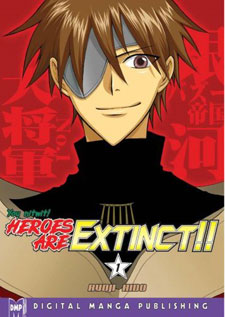
Heroes Are Extinct!! Volume 1 by Ryoji Hido Released by Digital Manga Publishing
Heroes Are Extinct is essentially one joke, but to its credit, the comedic irony of the situation works regardless of an pre-existing affection for the Power Rangers sentai and space opera conventions being parodied. In theory, once upon a time, Earth had heroes who dressed in bright uniforms, posed and recited noble oaths and defend the planet from evil invaders. Unfortunately, when the saucer fleet of the Galactic Bazue Empire arrives, these heroes do not exist. When the hordes of masked minions arrive, lead by Commander of the Earth Invasion Force: Grand Galactic General Cassiel (a hopeless romantic), Officer of the Earth Invasion Force: Grand General Aster (an air head) and Princess of the Bazue Empire: Grand Galactic General Velvet (a spoiled princess), they find themselves looking for an adversary that only appears in children's television shows. As the warrior of the three, Cassiel is particularly crushed that Earth has nothing to offer other than modern conveniences. When humanity will not even rise up to his invitation (scrawled flyers hung around the city), he decides to kidnap a group of teens and train them to take after television's color-coded warriors. As genre humor, it's hilarious to see the grand ideals and planet shattering dilemmas of a Leiji Matsumoto style space epic reduced to the kind of obsessions that would occupy a bored worker. From Captain Harlock to Darth Vader, that brand of story is full of individuals who immediately looked like something significant. The anime version of Martian Successor Nadesico made the joke that commanding in epic sci-fi is all about looking the part. Heroes Are Extinct brilliantly reduces the larger than life qualities of these legendary looking figures into vapid whims. What makes the gag grounded, and suggests real experiences is that the people depicted aren't necessarily unintelligent, but in the face of real problems, they are critically distracted by superficial fancies. On the sentai side of the equation, the manga willfully ignores that anyone who is not an elementary school age child recognizes the the shows always teeter, if not plunge into absurdity. It's part of the series' conceit that Cassiel takes the idea seriously, but from that point, the process by which he develops a team of heroes and the kidnapped candidates latch on/ fall victim to Stockholm syndrome and take to it seriously works well as a project gone amuck. The series has gone on to spice up the stories with its own absurd contributions, such as a nosferatu-like fourth general who ties ribbons on people. So far, these jokes have sat along side the parodies well. As has Ryoji Hido's bishonen (cute guy) style illustration, which might be reason enough for some to check out the series.
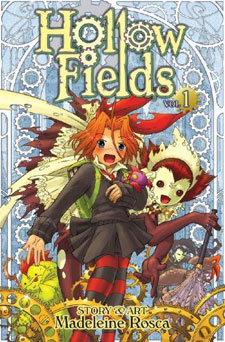
OEL Spotlight: Hollow Fields by Madeleine Rosca Released by Seven Seas
Hollow Fields serves as a welcome, boisterous counter-point to post-Potter magical school fiction. Creator Madeleine Rosca was recently recognized in Japan's first International Manga Award, but the work itself does not closely conform to prominent the features of manga, or for that matter, western comics. Instead, Hollow Fields' kinetic springiness and jack-in-the-box surprises suggest an animated work. Rosca is not a creator who has borrowed a page from Jhonen Vasquez's book, but as much as her mad scientist's bordubg school from hell stories invokes Harry Potter and David Copperfield, the experience of her tale does resemble that of Invader Zim. After a stormy ferry ride, Lucy Snow arrives at the village of Nullsville. She asks a hooded ferryman for directions to Saint Galkat's Academy for Young Ladies, but when she runs off, she finds herself in the type of forest that looks like the wrong fork in the road from a Looney Tunes fairy tale. This route leads her to Miss Weaver's Academy for the Scientifically Gifted and Ethically Unfettered. There, she is greeted by a suspended, spherical core that attempts to fend off the intruder with a Macross/Robotech style scrambled dispersal of missiles. If the series is informed by Japanese pop-media, it is evident in moments like this, with nods to less expected segments. When Lucy screams out that she is a new student, the pod opens up and a daffy looking woman, who is part rag doll part cheesecake anime maid stumbles out. Wowed by the large, individual rooms of the dormitory and apparent luxury, Lucy agrees to sign a contract to enroll at Hollow Fields. During her first meal at the school's dining hall, Lucy discovers that each week, the student with the lowest performance scores is sent to the school's windmill for detention, and never returns. THEN, she learns that the school's curriculum includes grave digging, creation of killer robots, and medical experimentation to breed chimera beasts. Rosca captures Lucy's dizzying experience of being launched into the unique environment of Hollow Fields by combining a clear, progressional narrative with a comic told in a jumble of irregular panels. Pages are never simply comprised of grids. Instead, panels overlap and dialog or figures break the boundaries. Maybe, if you dabble in comics rather than read them regularly, this could be a problem, especially given that (presumably for international distribution), the original English language comics read right to left. However, this compliments the energetic pace of the volume and contributes to a sense of cartoon buoyancy. This book is marked "all ages," and for the most part that seems sensibly, though parental appreciation for brain harvesting might vary. The young characters do look appropriately young, which is a nice change of pace from a lot of manga, but there is something jokingly suggestive about some of the bosomy teachers. From a lumbering stuffed animal to a teacher in a latex-y one piece and nurses cap, there is a lot going on the in comic's design, but everything ultimately gels nicely. Along with the pacing, the work is cinched by a unified direction for all of the elements involved. At no time does it work cross purpose to its own design. Through the cast of teachers, rivals and peers everything is contributing to this ominously madcap school. Everything is tuned to evoke a reaction to the particular location and plight.
ADV Posted then Removes Kanon Trailers
Anime on DVD noted that ADV Films posted trailers for the 2006 anime adaptation of the bishojo (cute girl) visual novel Kanon high (the game had previously been adapted in 2002). The company has not official announced acquisition of the license for the series, and they appear to have taken the trailer offlines.
Petit Eva
Anime News Network reports that indications suggest that upcoming Puchi Eva ("Petit Eva") super deformed Evangelion consist of three CG shorts directed by Shunichi Miki. The "Taizo" ("Exercises") short will feature super-deformed, computer-rendered Evangelion characters as they perform a rhythmic dance. "Hiru Yasumi" ("Noon Recess") and "Soji" ("Cleaning") will be nonsensical gag pieces about daily life at Nerv School.
Xenosaga Premieres August 30 On Anime Network
The Anime Network's Video on Demmand service will be running the premiering sci-fi game adaptation Xenosaga starting on August 30th. ADV Films will be releasing the first DVD of the release on 9/11/07. Synopsis The year is T.C. 4767. Four thousand years have passed since humanity abandoned its birthplace, the planet Earth. Beset by the hostile alien Gnosis, mankind is now scrambling to find ways to defeat this threat to their existence. The development of KOS-MOS (a specialized android with amazing capabilities) by Vector engineer Shion Uzuki was one response to the threat. But when their ship is destroyed by the Gnosis, Shion and her companions find themselves thrust into the middle of a battle with no clear sides...
New Yamato USA Figures
Yamato US announced that a tranformable 9.85" tranformable GN-U figure of the Braiger from Galaxy Cyclone Braiger in January 2008 for $168.00. Braiger can be transformed through interchanging parts into three styles - Braiger, Bri-Star, and Bri-Thunder and is packaged with Bri-Cannon, Bri-Sword and Bri-Spear as accessory parts.A Sonsaku Hakufu (Fighting) EX: Ikkitousen (a.k.a. Battle Vixens) will be released in ecember 2007 / January 2008 with an MSRP of $68.00. (The dress is apparently removable)
Dark Horse Talks Gantz: "The Deadliest Ball since Phantasm!"
Dark Horse has tentatively scheduled a summer 2008 release for Hiroya Oku's popular seinen manga series Gantz, which the publisher is describing as " hardboiled universe of ultra-stylish violence, pathos, and sexiness." Gantz tells the story of a team of dead people who are forced to take part in a "game" that has them hunting aliens and other creatures who live among the populace of Japan. The story focuses on Kei Kurono, a teenage boy who died saving a homeless man from a train. He, along with a band of others who are recently deceased, is forced to complete a series of dangerous and complicated missions by a strange device called Gantz. On these missions characters can even die again, only to be quickly replaced by others like them. As the plot progresses, so does the intricacy of relationships between characters.
Toomani Jetstream Celebrates Anniversary
July 17 marked the first anniversary of the Toomani Jetstream 24/7 broadband partnership between Cartoon Network and VIZ Media. According to internal statistics, the site has streamed more than 115 million video segments in just its first year and attracted an average of 1.7 million unique visitors each month. Toonami Jetstream currently allows users to watch streaming episodes from a number of hit series such as Naruto, Zatch Bell! And PokÈmon. In addition, the site offers 24/7 access to full-length episodes of international hit series Hikaru No Go that is not currently offered on U.S. broadcast or basic cable television. Fan response to MƒR and The Prince Of Tennis, which debuted exclusively in the U.S. on ToonamiJetstream.com, propelled the two shows to now air on Cartoon Networkís Saturday prime time block, Toonami. Upcoming offerings include: One Piece (August 13) ó Based on a highly successful Japanese manga series, One Piece has spawned more than 300 episodes and eight movies in Japan. In the Great Age of Piracy, Monkey D. Luffy along with his motley crew of pirate friends hopes to use his magical stretching powers and endless optimism to find the legendary treasure of One Piece and become the Pirate King. Dragon Ball Z (Sept. 10) ó Dragon Ball Z made its U.S. debut on Cartoon Networkís Toonami block in 1996 and airs during the Toonami programming block Saturday nights. Continuing on from the Dragon Ball series, Dragon Ball Z takes on more of a serious tone, focusing on Goku and the Z Warriors protecting Earth from an endless string of bloodthirsty villains bent on the total domination of the universe. Dragon Ball Z sheds light on Gokuís origins as it follows him through adulthood with his family and friends. Zoids GenesisTM (TBD) ó Zoids Genesis is the fifth series for the Zoids animÈ franchise. A young excavator named Ruge awakens the mighty Murasame Liger Zoid and joins the fight to restore peace to Planet Zi from the militaristic nation of Digald. Bobobo-bo Bo-bobo (Nov. 5) ó Bobobo-bo Bo-bobo strays from most animÈ shows with its ludicrous and often surreal comedy. Puns, breaking the fourth wall (speaking directly to the audience), and popular-culture references accent the action and adventure in this series. In the 31st century, Bo-BoBo harnesses his infamous Nose Hair Karate techniques to bring justice to the vicious Hair Hunters and to ensure the safety of hair everywhere.
Seven Seas Releases New Aoi House
Seven Seas has announced that the newest entry in its original English language anime geek comedy Aoi House In Love! Vol. 1 is in stores nows. Aoi House In Love! Vol. 1 collects "The Great Con Caper" story arc along with an assortment of extras not available anywhere else. The volume also includes eight full-color pages reprinting the first year of Aoi House 4-panel gag strips that originally appeared in Newtype USA.
Viz Talks New Licenses
VIZ Media made a series of notable announcements of several highly anticipated new anime and manga properties at the recent 2007 Comic-Con International. DEATH NOTE, which is presently available for digital download, will be released on DVD in November with subtitles and newly dubbed audio, and a special limited edition will also be issued that features a collectable figurine of the shinigami Ryuk. Later volumes of the collectorís edition will include figurines of Light, L, Misa, and other popular characters. The first BLEACHô DVD Box Set is set for release in October. VIZ Mediaís newest anime acquisitions also expand the SHOJO BEAT imprint. It was announced that the NANA anime series is being prepared for domestic release and HONEY AND CLOVER has also been licensed. SWITCH, set to debut in March. The new series is an action crime drama centering on narcotics investigator Kai Eto, who looks like a squeaky clean kid but hides a violent alter ego and a dangerous past. Together with his stoic partner Hal Kurabayashi, the detective must track down and stop the distribution of a dangerous new drug, Dragon Speed. NIGHTMARE INSPECTOR: YUMEKUI KENBUN will debut in April 2008 and will captivate fans with gothic shojo-style of artwork mated to a supernatural mystery story in the tradition of great comics like Sandman and House of Mystery/House of Secrets. For those who suffer nightmares, help lies in wait at the Silver Star Tea House, where patrons can order much more than Darjeeling. Hiruko is a special kind of private investigator. Heíll enter his clientsí dreams and rid them of their darkest visions ñ but only at the risk of exposing their darkest secrets! THE RECORD OF A FALLEN VAMPIRE will launch in May and tells the story of a Vampire King that has lost his kingdom and his queen. A thousand years ago, humans took the queen hostage during an attempt to kill the king. Trying to protect him, the queen unleashed her power, nearly destroying the world in the process. Unable to kill the queen, the humans sealed her away and erected thousands of fake seals so that the king can never find her. The kingís search continues even today. SHOJO BEAT was pleased to announce the forthcoming releases of paperback versions of romantic novels including KAMIKAZE GIRLS (Jan. 2008), SOCRATES IN LOVE (Feb. 2008), and BE WITH YOU (Feb. 2008), with a subsequent BE WITH YOU manga series also set to debut in February 2008. New SHOJO BEAT manga series for 2008 will include HONEY AND CLOVER, a slice-of-life story set at a Tokyo art college, and MONKEY HIGH!, a story about a teenage girl that falls in love while dealing with a new school and family problems, both set for March release. April will offer HARUKA - BEYOND THE STREAM OF TIME, a coming-of-age fantasy tale about a teenage girl named Akane who is sucked into a mysterious well that brings her back in time to the Heian period of ancient Japan! There, Akane learns that she is the Priestess of the Dragon God and the only one who can stop the notorious Demon Clan from taking over the capital city. Actionóand romanceóensues when Akane meets the Eight Guardians: young men who have sworn to protect her as she completes her destiny! May will bring the debut of Kaori Yuki's FAIRY CUBE. The popular creator of ANGEL SANCTUARY, GODCHILD and THE CAIN SAGA offers a new supernatural adventure story about a teenage boy whose life is being taken over by a renegade evil spirit. Trapped in the mystical land of Faerie, Ian must figure out how to return to his own world and stop the lizard spirit from stealing his life, his family and his girl. Also set for a May debut is B.O.D.Y. Everyone thinks 16-year-old Sakura has weird taste in guys because she canít stop drooling over Fuji, the strong silent type who sits next to her in class. When she discovers he works for a host clubówhere women actually pay men to date themówill she finally wise up? Only one thingís for sure in B.O.D.Y.óyou canít put a price on love! She could hire him to date her, but sheíd rather win his heart. VIZ Mediaís SHOJO BEAT magazine was also pleased to welcome renowned manga creator Arina Tanemura for a special discussion on her work. Several new titles by the creator of popular shojo series like FULL MOON and THE GENTLEMEN'S ALLIANCE Ü, both published domestically by VIZ Media, will include I.O.N in April 2008. The series centers on a high school girl that meets the president of the Psychic Powers Research Society, and discovers when she touches a mysterious substance he made, that it gives her telekinetic powers when she chants the letters of her first name, I-O-N. TIME STRANGER KYOKO will be released in July. The story is about a princess in the 30th century who has been happily living among the commoners until age 16, when she is supposed to ascend the throne. The king will let only Kyoko continue living as a commoner if she can revive her twin sister who has been trapped in time since birth. August will offer SHORT-TEMPERED MELANCHOLIC AND OTHER STORIES and, later in the year, a gorgeous presentation of THE ART OF FULL MOON, compiling a variety of Arina Tanemuraís vivid artwork from the series, will be released. The SHONEN JUMP panel offered more news on DEATH NOTE, now one of the hottest manga and anime series in North America. New DEATH NOTE print titles for 2008 will include DEATH NOTE HOW TO READ 13 in February, which is the ultimate encyclopedia of all things DEATH NOTE. Readers will even discover the mysterious character Lís real name on a special trading card included with the edition. February will also see the release of DEATH NOTE: ANOTHER NOTE THE LOS ANGELES BB MURDER CASES. This is an original novel based on characters and concepts from the manga, anime and movie that takes place in Los Angeles with detective L working with a former FBI agent to help the LAPD investigate grisly serial killer crimes. New SHONEN JUMP manga will include the release of RAL O GRAD in February. The series features artwork by DEATH NOTE creator Takeshi Obata and tells the story of a young boy named Ral who was locked in a world of darkness for 15 years because the villagers were afraid of him. When Ral was an infant, a dragon-shaped Shadow named Grad living inside of him destroyed his village. Shadows have no form but when they emerge into the world of light, they take over the body of a living creature. Set free after the Shadows invade the kingdom, Ral is released into the world of light and quickly discovers women. Heíll do anything for them and his main goal is to protect every beautiful female in the world. Other SHONEN JUMP debuts include GUN BLAZE WEST by Nobuhiro Watsuki (creator of RUROUNI KENSHIN and BUSO RENKIN) in April. A Wild West action and gunplay manga about a boy who befriends a vagabond in search of the sacred land named Gun Blaze West, where only the strong can set foot. SHONEN JUMP rounded out its announcements with news of a special NARUTOô Deluxe Box Set, going on sale the week of Thanksgiving, containing the first 27 volumes of the NARUTO manga series along with several limited edition premiums. In February, NARUTO: THE OFFICIAL FANBOOK debuts, filled with artwork created by the fans of the series. The new story arc for NARUTO also begins in March of 2008 with volume 28, which finds the main characters two and a half years older.
Worth Checking Out
Same Hat! Same Hat! has posted Shintaro Kago's Blow Up Via A Geek By Any Other Name, superflat artist Takashi Murakami working with Kanye West here Twitch notes that Grady Hendrix's Kaiju Shakedown has return. To access it, visit Variety Asia Online , click on "Departments" in the top menu, select "Kaiju Shakedown." MangaCast's 100 Manga Magazines in 60 Minutes with J. Thompson Bookslut interviews Vertical's Anne Ishii ICV2 talks to Del Rey's Dallas Middaugh here A rather frightening consequence of the maid fetish via Danny Choo Speaking of scary, "Painful MOE BIKES in Akihabara!" Mecha Mecha Media looks at the efforts to halt the construction of Kazuo Umezu's "strange house" here The Newsarama Blog looks at Italian fashion designer Miuccia Prada's contribution to Appleseed: Ex Machina here Via Kotaku, the dance for the recently reviewed Haruhi all over Japan: It kindof calls to mind the dancing portion openning of Dai Mahou Touge, only without the fire...


